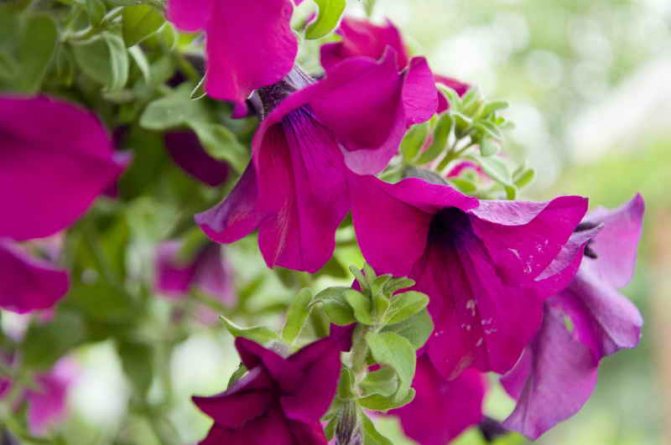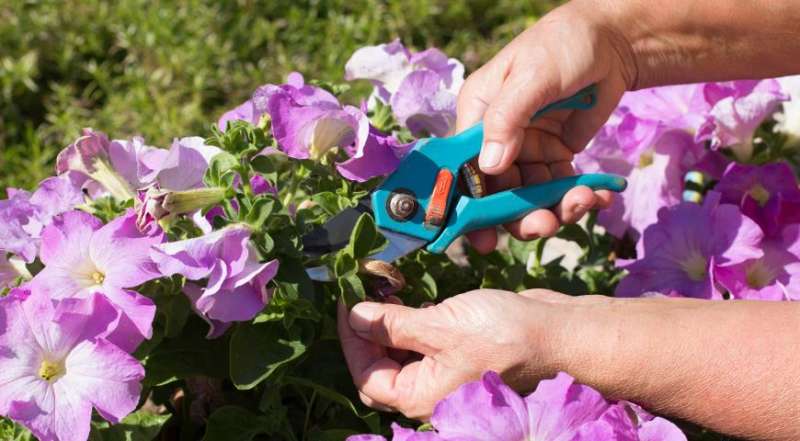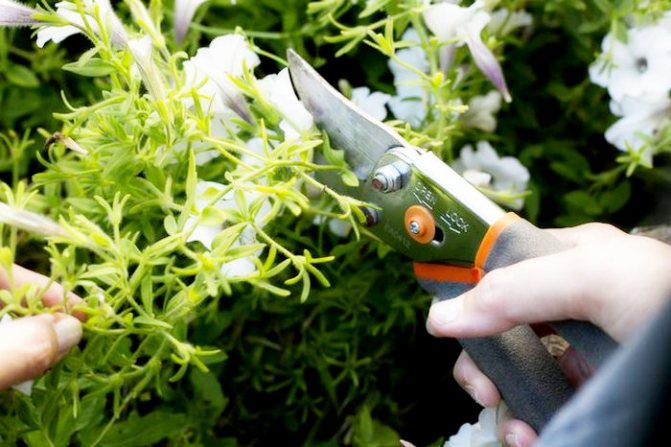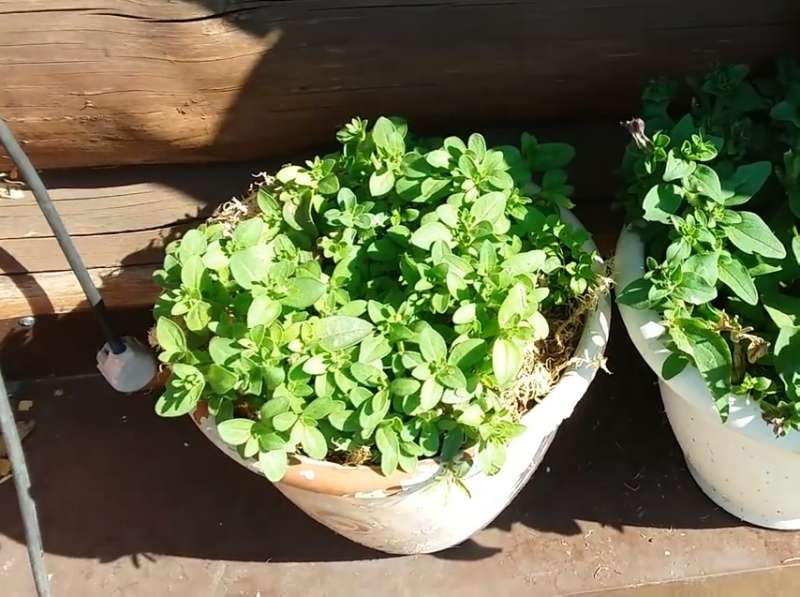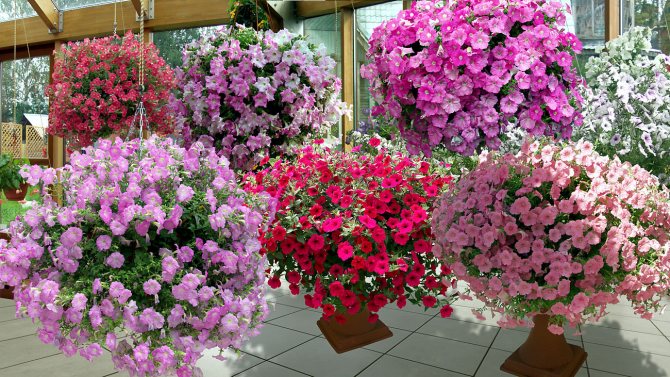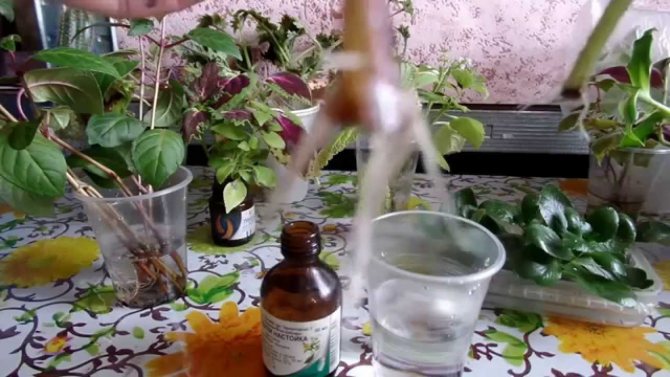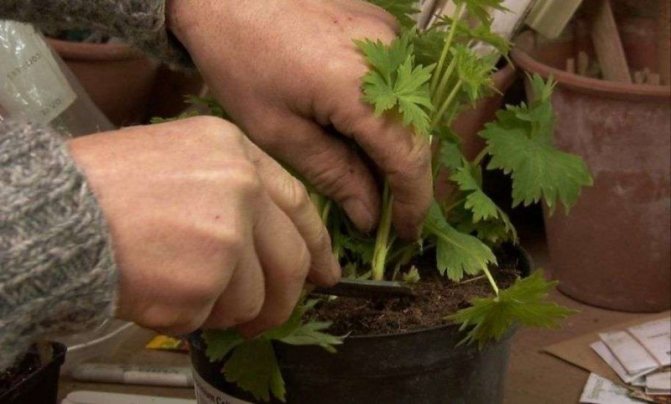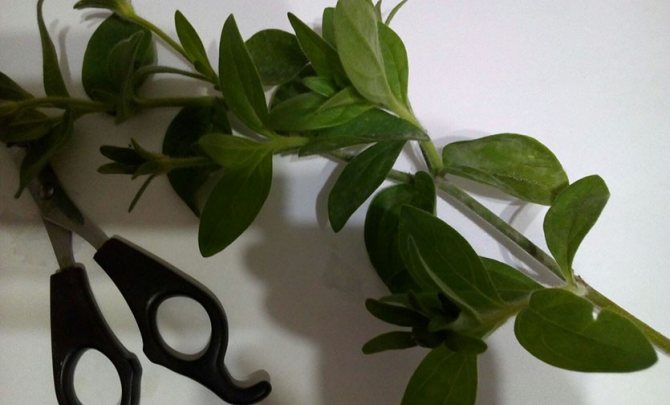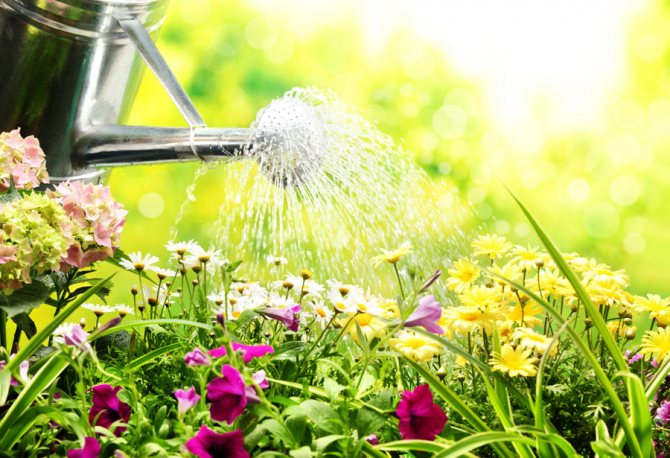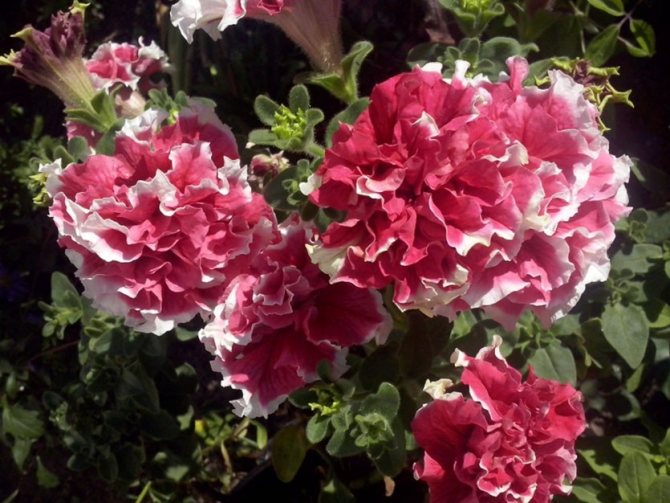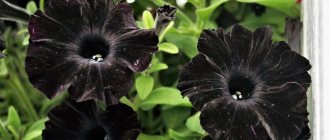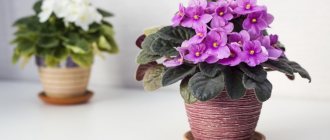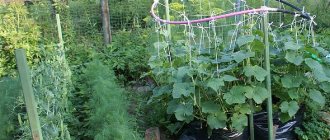Volumetric multi-colored bushes of terry, ampel, two-color and monochromatic petunias have won the hearts of experienced gardeners and beginners. From mid-spring to the first frost, flowers, amazing in their diversity and decorativeness, adorn not only summer cottages, but also balconies of multi-storey buildings, verandas of cottages, city flower beds, cafes and restaurants. The flowers are unpretentious, do not require professional maintenance and special conditions, but they respond graciously for the care of flower growers.
A few words about petunia
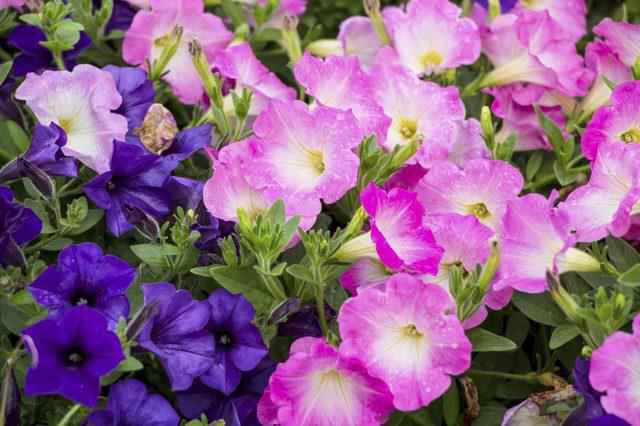
This flower is loved for its incredible beauty and long flowering period. Petunia blooms in late spring and blooms until mid-autumn, so it will decorate your garden or apartment for a long period of time. Most gardeners grow petunia as an annual plant, as it begins to bloom in the first year after planting. If you have a rare variety, then it makes sense to leave the flower for winter storage. How to preserve petunia in winter will be discussed further.
A little about the amazing transformation
The familiar petunia is no longer the same shy girl with monotonous small flowers that we knew a couple of decades ago. During this time, breeders have bred a huge number of varieties and hybrids of the most fantastic colors, moreover, exuding an amazing aroma. An ampelous variety of petunia, unknown to us before, appeared, varieties with huge double flowers.
In its homeland, Montevideo, this decorative perennial grows and blooms almost all year round. In our conditions, this riot of colors is interrupted by the first frosts. Petunia does not always survive until autumn in such a well-groomed condition, as in the illustrations in landscape design publications, where it looks like a ball, which seems to consist of only flowers. However, to form it in this way is within the power of every amateur florist.
What are the advantages of winter storage?
Compared to annual sowing, winter storage has the following advantages:
- Early flowering - the planting material takes root much faster in a new place and blooms much longer. At the same time, the buds can bloom at the end of winter.
- Easy propagation - you do not need to sow seeds as you will already have ready-made seedlings. Thus, you will spend less time and effort, and petunia, the photo of which looks just amazing, after just a few weeks will start to delight you with its beauty.
- Storage in winter allows you to breed rare plant varieties that do not produce seeds, but reproduce only in a vegetative way.
Thus, if you want to breed petunias in your garden, it is best to do this with winter storage.
Time to pinch petunia
Has the plant started to grow actively? This is a sure sign that you need to start pinching the bushes. This phenomenon is associated with the growth process along the stem. First you need to find the bottom of the branch. Four or five leaves are counted from it. The upper part of the shoot is the zone where the flower begins to grow. It should be pinched off with your fingers.After that, the growth "in length" slows down somewhat, however, the activity of additional lateral parts of the shoot is activated. After such a simple operation, more flowers appear. This method should be repeated after one month.
Mother plant
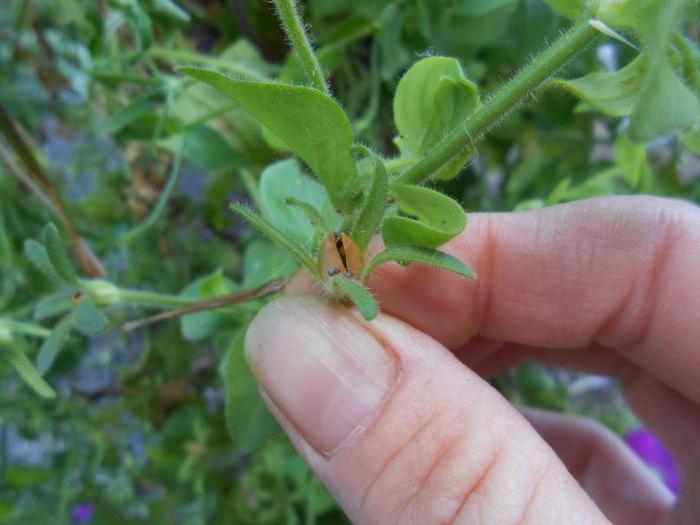

The mother plant is an adult flower that is placed in winter storage for the purpose of propagation by cuttings in the spring. Adult flowers are dug up at the end of summer and planted in pots. During the fall, the plants will have time to take root and get stronger before the onset of winter.
In this case, dried leaves and dead sprouts should be removed from the petunia. Experienced growers recommend completely cutting off dead wood, and leaving approximately 12 centimeters from the total length of the shoots. The mother plants are stored in a cool room with low humidity. Unheated glazed balconies are a good option. With the arrival of spring, it is necessary to create good lighting and high humidity for the mother plant. This will wake up the flower, and it will start new shoots.
Gardening tips
Feeding strawberries during flowering and berry setting
It is not always necessary to feed petunia with chemicals. There are a lot of tools that gardeners use. They know how to make petunia bloom profusely using folk remedies.
- The most effective top dressing is wood ash. It eliminates the foci of many diseases, saturates the plant with vitamins.
- Active growth is observed after feeding with a solution of poultry manure, which has many minerals.
- Fertilizing with succinic acid is an excellent prevention of fungal diseases.
- Boric acid causes abundant flowering, only you need to carry out foliar feeding.
- The strength of the flowers is given by the nettle solution.
Yeast feeding for petunias
The most affordable and effective fertilizer for flowering petunias is yeast. They are so versatile and well accepted by the plant that they can be introduced starting with the development of seedlings.
Yeast can be applied at the root, sprayed with foliage. Moreover, you can use both dry and live yeast.
- Raw yeast
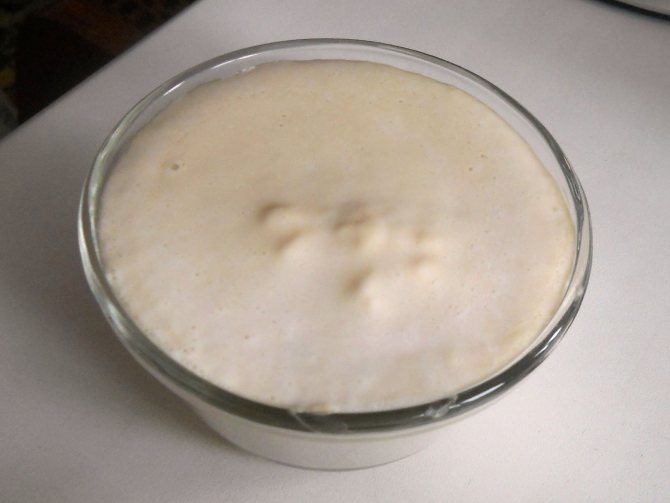

Yeast
Live yeast is diluted with warm water (1: 5) and left until the end of fermentation, overnight. In the morning, the concentrate is additionally diluted (1:10) with warm water and set aside until evening. Top dressing is carried out at the root in the evening.
- Dry yeast
It is considered the most budgetary option. The yeast itself will need 10 g, sugar - 60 g and a bucket of water. After two hours of infusion, the volume is brought to 50 liters.
Stimulating fertilizer perfectly nourishes petunias, causing vigorous flowering, rich colors.
Important! Do not add any organic matter to the yeast solution.
If petunia does not develop well
Often there are moments when, having just appeared, the seedling stops developing. Several factors can cause this problem:
- Incorrectly selected soil mix. Perhaps the soil is acidic or alkaline. Change the soil immediately.
- Also, the roots of the seedling may not have enough space for development. In this case, growth also stops. It is necessary to transplant the petunia into a larger pot.
- Lack of nutrition can inhibit flower growth. It should be noted that from 2 weeks the seedlings must be constantly nourished.
Fulfilling very simple and fairly simple conditions for keeping petunias, even a novice florist can grow magnificent, abundantly flowering plants that will delight the eye until late autumn.
Preparation of planting material
So, we looked at a way to keep vegetative petunias in the winter. But what to do with the plant next? If you live in an apartment, then it is quite difficult to create conditions suitable for grafting due to the strict restrictions on free space.If you will be storing the mother plant in a warm room, it is best to use young flowers for this, as they are more robust and they are much more likely to overwinter normally. For grafting, it is better to use small pots, since they take up less space and will be easier to arrange around the apartment.
Cuttings are cut into small lengths, approximately 10 centimeters each. 2 leaves are left on them, which are also trimmed. This is necessary in order to reduce moisture loss. Rooted cuttings need the same care as regular indoor flowers. They must be watered in a timely manner, as well as ensured with optimal air humidity and the required amount of light. Cutting petunias in the fall is considered the best option, since the plant will be able to form a root system in two weeks and get stronger before wintering.
Why do you need to form a bush
To bloom petunia as early as possible, her. Until the time of flowering, the seedlings will have to live in the room for 2-3 months. Conditions do not always allow creating the necessary microclimate for tender sprouts, finding enough space and light sources. Saplings stretch out, become fragile, lean to one side, and their decorative qualities suffer from this.
Pinching, or pinching, is one of the most common methods in floriculture. It is used to stimulate the growth of side shoots and make the bush more leafy and compact. Pinning is used not only by flower growers, but also by gardeners and gardeners. For example, if you pinch the central shoot on cucumbers, then the most productive side lashes will grow. And pinching stepsons on a tomato will help him not to waste energy, but to use it for the formation of fruits.
Cutting at home
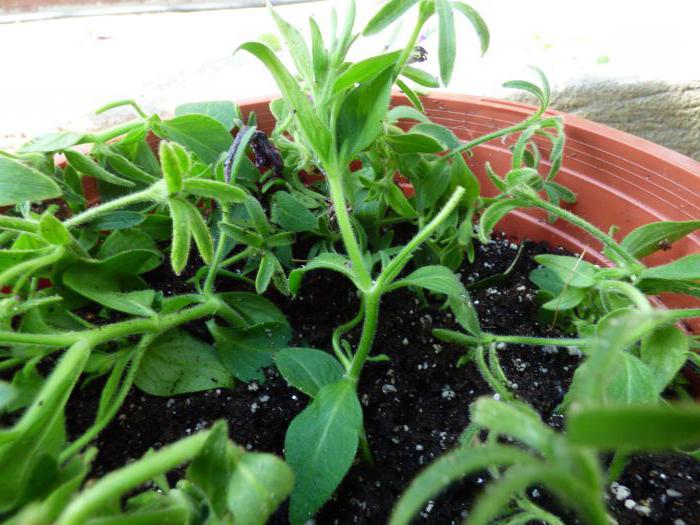

All hybrid varieties do not propagate by seeds, but if you want to breed some rare petunias at home, for example, terry or large-flowered, then this can be done quite successfully using cuttings. In this case, petunia, the photo of which is striking in its beauty, will retain its properties and take root well in a new place after planting.
Cutting is the best method of propagation compared to planting seeds, since about 95 percent of the seedlings take root, while about 25% of the seeds simply die and do not germinate.
Seedling care
In order not to destroy the plant, you need to properly care for it and monitor each new shoots:
- it is necessary to plant seedlings in the ground in the second half of May, tightly to each other. The land should consist of a mixture of humus and sod land;
- cuttings need frequent watering, and in the heat, you also need to add spraying from a spray bottle;
- once a week, you need to feed the stalk under the root and spray it (you can read about feeding petunias at home);
- if your flower does not want to grow, you need to "help" it with the help of growth stimulants;
- try to remove dried flowers in time. So the flower will develop faster and form new buds, and will have an attractive appearance in general.
Petunia is a very beautiful flower with many different species, varieties and color palette. It will become one of the main accents of a flower arrangement in your garden.
To achieve good and timely flowering, the plant needs to be looked after.
If you do not do this, then achieving chic flower beds will become an unattainable dream. So monitor the condition of your petunias, pinch them in time, fertilize them, and they will thank you with bright flowering.
From the following video
You will learn how to pinch a petunia correctly:
Pinching petunias: why and when ...
Volumetric multi-colored bushes of terry, ampel, two-color and monochromatic petunias have won the hearts of experienced gardeners and beginners.From mid-spring to the first frost, flowers, amazing in their diversity and decorativeness, adorn not only summer cottages, but also balconies of multi-storey buildings, verandas of cottages, city flower beds, cafes and restaurants. The flowers are unpretentious, do not require professional maintenance and special conditions, but they speak favorably for the care of flower growers.
Prerequisites for pinching a petunia How to pinch a petunia Useful tips
Prerequisites for pinching petunias
Proper cultivation and shaping is essential for a beautiful and healthy bush. In addition to timely sowing and diving, it is necessary to correctly pinch the petunia. This means that at a certain stage of growth, she needs to remove the upper shoots. This procedure will ensure the branching of the stems and the formation of many buds on the bushy crowns.
To carry out this manipulation, you will need the following:
comfortable scissors or pruning shears; matured seedlings with 4 - 5 large leaves at the top; container for collecting removed cuttings.
How to pinch petunia
Before pinching petunia, it is advisable to familiarize yourself with the basic requirements for this procedure.
Observing the growth of seedlings, it is necessary to choose a period when it has grown a little stronger and soon began to grow upward. It can have up to 5 - 6 leaves, but not more. If you skip this moment, the seedlings will stretch out. The actual pinching of the petunias will not take long. It is necessary to cut the stem over 5 - 6 leaves with your fingers or shears. This is how a new point of growth is formed, from which several shoots will begin to grow simultaneously in different directions. During this period, seedlings can slow down development, but at the same time they will get stronger. When the side shoots go, the bush will take on a more rounded appearance. If you plan to plant seedlings in open ground, then pinching is best done after rooting. The sprout will take several days to adapt. During this period, you need to try to create favorable conditions for plants to take root:
you need to plant seedlings loosely, observing the conditions of agricultural technology; keep track of the frequency of watering and spraying; apply a specialized strengthening fertilizer at the root.
If development takes place in a greenhouse, you can pinch the petunia after diving.
If the cut shoots are not very small, they can be used as cuttings. In order for the cutting to take root, it is placed in a container of water. First, you need to remove the extra leaves, leaving a few in the upper part. When the roots appear, they are transplanted into the soil. This way you can get additional young seedlings.
Useful Tips
when pinching, try to injure the sprout as little as possible, use clean tools; a month after the event and the appearance of strong lateral branches, pinching the tops of petunias can be repeated; for laying large buds on new stepchildren, use suitable
fertilizers, they will make the flowers brighter and larger.
In order for a formed decorative bush to please with its beautiful appearance as long as possible, it will need constant care. From the moment of sowing, not a single transplant, pinching, spraying of sprouts will be required. Do not forget to water and feed well, remove dried flowers and shoots. In place of the cut old flowers, new branches with buds will appear. Well-groomed colorful petunias will undoubtedly delight you with abundant and long flowering in gratitude.
How to pinch petunia correctly (video)
glav-


Multi-colored voluminous petunia bushes have already won the hearts of many experienced and novice florists and gardeners. Their flowering period is mid-spring and before the first frost. They are used to decorate summer cottages, flower beds, balconies, verandas, restaurants and cafes.This flowering plant is not whimsical. However, one of the most important agrotechnical issues deserves attention, since the development and abundance of petunia flowering depends on this. This article will show you how to pinch a petunia.
Preparation for wintering
So, we have already answered the question of how to preserve petunia in winter. But it is also very important to properly prepare the cuttings for transplanting to open ground.
Before planting in the garden, the cuttings are placed in small containers filled with loose earth. Planting depth should not be too deep. About two centimeters will be enough. The containers with sprouts are covered with foil to create a kind of greenhouse. To provide the plant with fresh air, several holes are made in the film.
Soil and microclimate
Heat-loving flowers begin to be planted after the onset of stable heat. The flower loves windless sunny places, but tolerates light temporary partial shade well.
Alkaline and strongly acidic soil reactions negatively affect the well-being of the plant. To the rest, the flower is indifferent, if they are nutritious enough, moderately loose, retain moisture well, but do not allow water to stagnate.


Petunia
To make the garden petunia lush and blooming, it is planted in loamy or sandy loam soil, fertilized with humus, compost. The increased acidity of the earth is neutralized with lime.
The correct composition of the soil is sand, peat, humus.
How to care for rooted outgrowths?
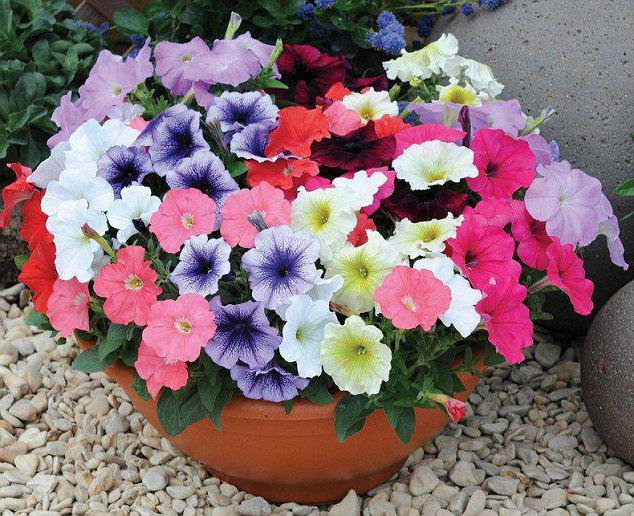

Answering the question of how to preserve petunia in winter, one cannot ignore the peculiarities of caring for rooted shoots. The root system of cuttings forms very quickly. In order for the process to take root and begin to develop, it takes about two weeks. Until the start of a cold snap, rooted cuttings can be stored outside.
After new shoots appear on the cuttings, it is necessary to transplant them and cut off the two upper leaves. Thanks to this, the flower will grow lush and beautiful. An important measure when caring for petunia is maintaining an optimal level of humidity. For this it is worth using humidifiers. If it is not at your disposal, then containers filled with water are placed near the containers with cuttings.
Petunia, which overwinters normally in most cases, needs periodic watering. You can determine the need for it by the top layer of the soil, which should be completely dry. But do not water too abundantly, as this can lead to damage to the plant with the disease "black leg", the cause of which is high humidity. If this happens, then the damaged shoots are removed, and the cuttings are treated with a weak solution of potassium permanganate.
How should you pinch a petunia?
Before pinching petunia, it is advisable to familiarize yourself with the basic requirements for this procedure:
- Observing the growth of seedlings, it is necessary to choose a period when it has grown a little stronger and soon began to grow upward. It can have up to 5 - 6 leaves, but not more. If you skip this moment, the seedlings will stretch out. The actual pinching of the petunias will not take long. It is necessary to cut the stem over 5 - 6 leaves with your fingers or shears. This is how a new point of growth is formed, from which several shoots will begin to grow simultaneously in different directions. During this period, seedlings can slow down development, but at the same time they will get stronger. When the side shoots go, the bush will take on a more rounded appearance.
- If you plan to plant seedlings in open ground, then pinching is best done after rooting. The sprout will take several days to adapt. During this period, you need to try to create favorable conditions for the plants to take root:
- you need to plant seedlings loosely, observing the conditions of agricultural technology;
- monitor the frequency of watering and spraying;
- apply a specialized strengthening fertilizer at the root.
If development takes place in a greenhouse, you can pinch the petunia after diving.
- If the cut shoots are not very small, they can be used as cuttings. In order for the cutting to take root, it is placed in a container of water. First, you need to remove the extra leaves, leaving a few in the upper part. When the roots appear, they are transplanted into the soil. This way you can get additional young seedlings.
- when pinching, try to injure the sprout as little as possible, use clean tools;
- a month after the event and the appearance of strong lateral branches, pinching the tops of petunias can be repeated;
- use suitable fertilizers for laying large buds on new stepchildren, they will make the flowers brighter and larger.
In order for a formed decorative bush to please with its beautiful appearance as long as possible, it will need constant care. From the moment of sowing, not a single transplant, pinching, spraying of sprouts will be required. Do not forget to water and feed well, remove dried flowers and shoots. In place of the cut old flowers, new branches with buds will appear. Well-groomed colorful petunias will undoubtedly delight you with abundant and long flowering in gratitude.
Growing petunias has become very popular. Many factors contribute to this. Firstly, varieties and hybrids of exceptional beauty and a variety of shapes, shades and species have appeared on the market. Secondly, it is quite simple to grow this flower, for this you do not need to be an inveterate florist: with regular care, it pleases the eye with bright colors until the very frost. And, thirdly, if an annual plant is brought into a warm room, it can easily become a perennial and give cuttings for vegetative propagation in the spring. This is how all the features of hybrid forms are transmitted when it is impossible to find the seeds of the variety you like.
Uterine plant transplant
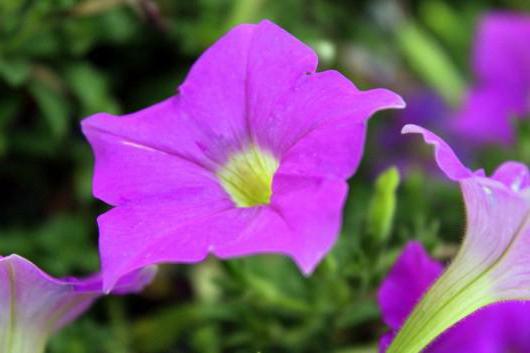

The mother plant should be replanted before frost. This is important as the flower takes time to take root. For this, healthy plants with lush flowering are selected.
It is forbidden to fertilize mother flowers with mineral fertilizers, which contain nitrogen. This is due to the fact that the plant will be stored in a cool room in winter. Potash and phosphate fertilizers are best suited to feed petunias.
Transplanting a petunia for the winter is impossible without creating high-quality lighting. The lower the air temperature in the room, the less light the plant needs. If you live in an apartment and do not have a cool room, then the lighting for flowers should be turned on for at least 10 hours.
How to make petunia bloom lush
How to get petunia to grow into a lush bush and bloom in lush color.
Petunias are one of the most popular annuals in the world. And this is not surprising, because they are delightfully beautiful. Today there are a lot of varieties of this "queen of the flower bed", differing in the height of the bushes, a huge variety of shades and the size of flowers ... What to do to make the petunia look more magnificent, so that it looks like a blooming ball - of course, PINCH !!!!
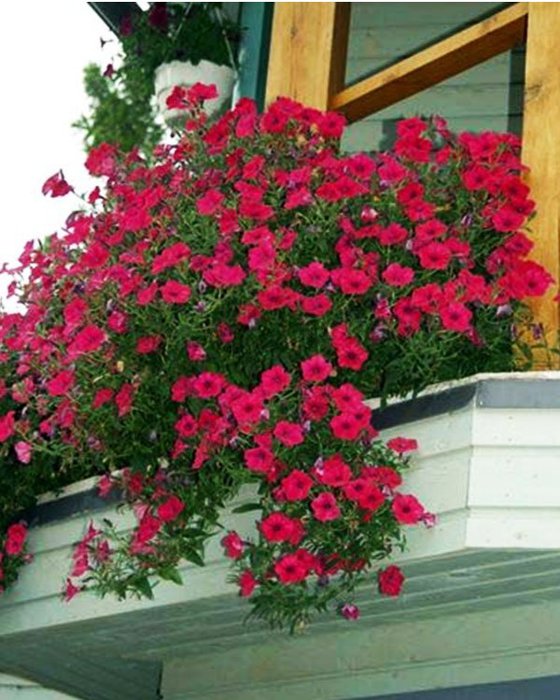

Usually, beginner growers (or those who still have their own difficulties with growing petunias from seeds) buy young seedlings, when the plant has very few stems, 5-6 pieces. It is at this age of the plant that I begin to make the first pinch. By pinching in the right place, you will provide strength to new shoots and then they will be resistant to mechanical damage. This is what the pinch should be. The separated piece of the shoot should be at least 3-4 cm.Why exactly so much and not less? If you remove only the tip of the shoot - (and this will be the thinnest place on the stem), then growing lateral shoots in this place will often break off in strong winds and bad weather.
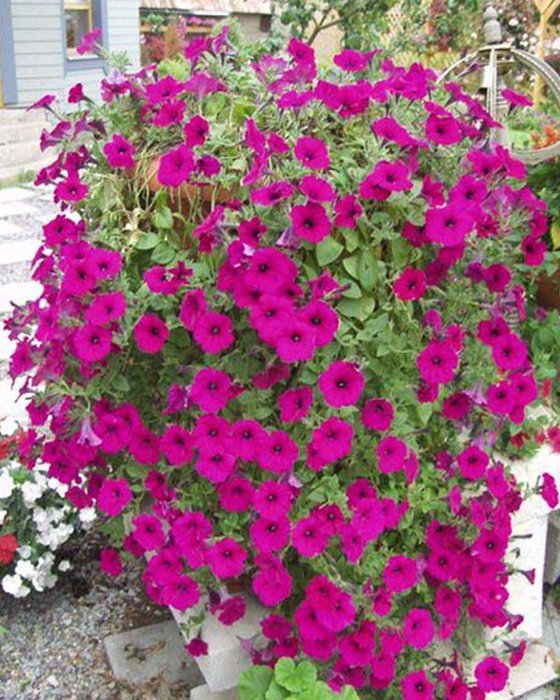

In order to develop lateral shoots, you need to cut, and it is best to pinch the top of the shoot. The separated piece of the shoot should be at least 3-4 cm. If you remove only the tip of the shoot - (and this will be the thinnest place on the stem), then growing lateral shoots in this place will often break off in strong winds and bad weather. More ... How many times per season should this procedure be performed? Pinching is carried out as the lateral stems grow. This means that as soon as the new lateral stems reach a length of about 10-15 (a little more is possible), the pinching can be repeated. And do this until the bush acquires splendor. But, take into account the fact that with the constant shortening of the stems and the intensive growth of the plant, additional feeding is required. If this is not done, then there will be a lot of new stems, they will be thin. You will not see abundant flowering. Only with good care, timely watering, you can achieve full return from the plant.
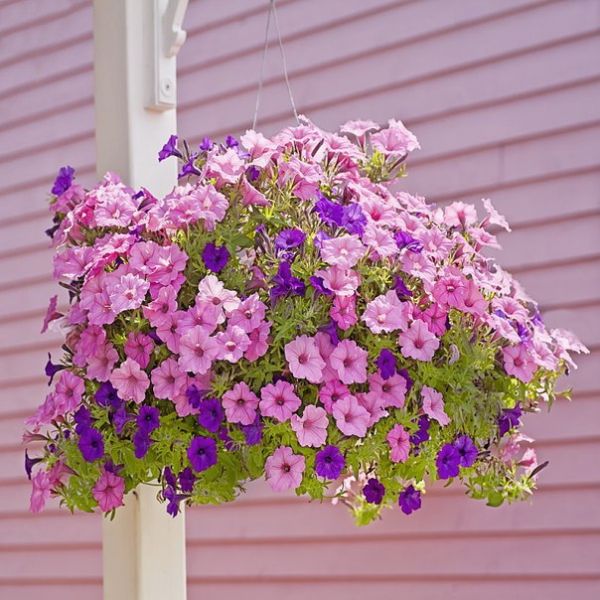

Another very important point! Remove all wilted flowers in time, they take a lot of strength from the plant - forming testicles. Here are all the important points! Rules for the successful cultivation of ampel petunias. Ampel, or cascading petunia, which has hanging, long and insanely beautiful shoots with exquisite flowers, looks great in hanging baskets and balcony boxes, attracting admiring glances. Surely, you have at least once tried to make your dream come true and grow such beauty with your own hands. But for many, even with a passionate desire, failure often lies in wait. Now the seeds will not sprout, then the seedlings will disappear, then the plant will grow weak and unsightly. But with the right approach, you can grow an ampelous petunia with a total area of about 2 square meters !! There is something to strive for!


The practice of growing petunias has derived the following formula:
large capacity + regular feeding, sufficient watering + removal of faded flowers. Large planting capacity. The root system of the petunia is very powerful, and it needs a lot of land. You need to proceed from the calculation - 5 liters of soil per plant. It turns out that you need to plant 2 petunias in a 10 liter container. In a balcony box 1 m long - no more than 3. If you plant more plants, the stronger ones will overwhelm the weaker ones.
Regular feeding.
Petunia is very fond of "eating". You need to start feeding already 2 weeks after the first pick of the seedlings. In the "childhood" age, fertilizers with nitrogen content are needed for growth. Later, phosphorus and potassium are required to set the buds. It is good to carry out foliar feeding with complex fertilizers with microelements. Iron for petunias is an important part of nutrition. Plants react to its deficiency by yellowing the leaves (chlorosis). Iron chelate, or its liquid form - "Ferovit", helps to correct this, 3-4 treatments are enough with an interval of several days. Adult plants need to be fed every 5 days, alternating root and foliar feeding. They are very fond of petunias potassium monophosphate. Sufficient watering. It is important not to overflow petunia shoots, they are very susceptible to a black leg. In general, adult plants love quite abundant watering. But short-term dryness of the soil is tolerated normally.
Removal of faded flowers.
It is advisable to regularly remove faded flowers. This provokes a new wave of flowering. But if suddenly it decreases, you can cut off the boxes with seeds and dead flowers, feed them and it will be again ... SUCH !!!
If you want the petunia to bush and not stretch one stem up, you need to pinch it over the third leaf. It is recommended to water the seedlings with a weak solution of manganese.The leaves will be juicy, and the flowers are large, the flowering period will increase. We will try, based on the experience of experienced florists, to correct the mistakes that you made when growing petunias. 1. Quality seeds. Buy petunias from Western breeders. There is NO selection and production of petunias in the CIS. The best recognized ampel petunias are: Fortunia (in several colors), Easy Wave (5 colors), Wave (5 colors), Tidal Wave (4 colors), Typhoon Wave (4 colors), Tornado (4 colors), Ramblin (8 colors) ). Seeds remain viable at home storage conditions for up to several years.
2. High quality soil. Petunias need a nutritious, loose soil that retains moisture well, but does not allow "sticking". It is difficult to get a good soil mixture on your own, so it is better to buy ready-made soils.
3. Sowing dates. It all depends on when you expect to bloom. The minimum development period for a young plant is 3 months. That is, you can sow seeds in February, but you can also in April, only then the beginning of flowering will be at the end of summer.
4. Sowing and transplanting. Cover the sown seeds with a layer of soil 1–2 mm. Cover the container with glass and periodically turn it over, avoiding "irrigation". When a rosette of 3-4 leaves appears, dive into pots 8-10 cm. Plant the grown petunias 1-3 plants in large containers or hanging baskets with a volume of 10 - 12 liters.
5. Watering. In the first week after sowing, spray the soil 1-2 times a day with water with the addition of potassium permanganate (light pink). By the time of the next watering, the soil should dry out a little.
6. Temperature. When sowing - 20-23 degrees. After germination - 18-20 degrees. After picking into pots, to enhance the growth of lateral shoots, reduce the temperature to 16-18 degrees.
7. Lighting. Lighting is an essential ingredient for success. After sowing, to stimulate seed germination, you need fluorescent lighting for 14 hours a day, gradually increasing this time to 20 hours. Mature plants will need plenty of sunlight. If the lighting is insufficient, the growth of lateral shoots will worsen, they will not stretch to the side, but up.
8. Top dressing. A week after the emergence of seedlings, you can begin to do foliar dressing - spray with water-soluble mineral fertilizers. In the future, use liquid complex fertilizers for flowers every 2-3 days. When the plants are strong enough, fertilizing can be combined with each watering. We wish you to grow such petunias with amazing flowering before frost.
But on this we do not say goodbye, come back again!
Subscribe to updates on our Facebook page so as not to miss the most interesting and be sure to share with your friends!
See you soon!
How to care for a mother flower?
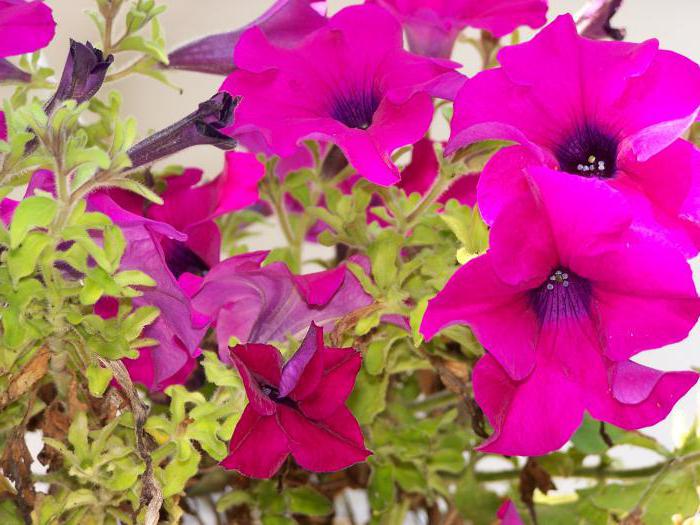

In order for petunia to undergo wintering normally and not start to fade, it is necessary to create suitable conditions for the mother plant under which it is stored. This is the only way you can keep him strong. It is important to consider the fact that mother flowers can behave in completely different ways. One part of them may hibernate before the onset of spring, while the other will actively develop and may even bloom. Most of the buds should be removed to keep the petunia strong.
For the wintering period, if the flower hibernates, there is no need to feed it. If petunia, the description of which can be found out from flower sellers, begins to grow and develop rapidly, then the plant should be fertilized with a small amount of potash fertilizers. In this case, you should monitor the condition of the plant and the presence of any diseases. If the flower begins to lose its strength and withers little by little, then most likely it is affected by powdery mildew. To combat this ailment, a sodium carbonate solution is used. In addition to diseases, the wilting of a flower can occur due to a lack of light.
In the middle of winter, uterine petunia should be fertilized with nitrogen. Also, the flower needs good lighting, without which it will not be able to form a strong root system.
Storing plants in winter allows you to get high-quality planting material, which will quickly take root in the open field and begin to bloom early. In addition, this method of reproduction of petunias allows you to preserve rare varieties of this incredibly beautiful flower that do not give seeds.
Interesting information
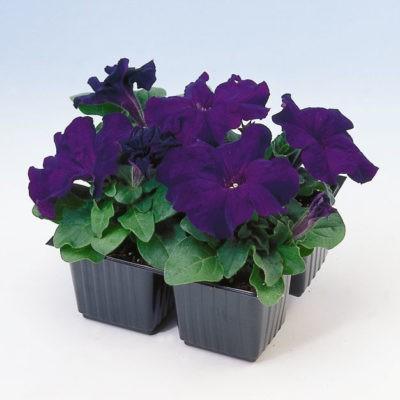

Petunia belongs to the nightshade. This means that potatoes and tomatoes are related to the flower.- The name of the flower in translation from the Brazilian language "petun" means "tobacco". For a long time, the plant was considered a close relative of tobacco and the plants belonged to the same genus.
- In 1921, an asteroid was named after the flower.
- Almost any flower color is possible. From one color to spots, dots and streaks. Petals also come in different shapes: smooth, corrugated and fringed.
- Terry petunias have no seeds. They cannot set seeds, as the ovary turns into petals.
- The birthplace of petunia is Uruguay.
It is not at all difficult to save petunia in winter if you follow certain rules. By doing them, you can get not only beautiful flowers, but also high-quality planting material.
Waking up from hibernation, petunia will demand your attention. To obtain abundant and lush flowering, you need to feed the plant and carry out regular pruning. Read our articles on how to care for a petunia during flowering and what to do if it doesn't want to bloom.
Why is grafting better?


Petunias by type of growth are divided into ampel and bush
.
Ampel petunias grow strongly and become a real decoration of the house and plot. Bush petunia bushes are not so lush.
There are two ways to store petunias in winter - in the form of a mother plant and cuttings
.
In order not to buy the seeds of the petunia hybrids you like, which are not cheap at all in winter, and to grow seedlings over a new one, it is preferable to carry out cuttings of the petunia varieties you like and keep the rooted cuttings in the apartment until spring.
In spring, cuttings grow very quickly and become beautiful bushes.
One more the reason for cutting petunias for the winter
- very often there are spontaneous mutations, especially in terry hybrids. A bush of a certain hybrid grows, suddenly one whip on it gives completely different flowers, they can change shape, size and even color. Thus, Surfinia appeared, it reproduces only by cuttings, there are no seeds in bags.
How to pinch petunia step by step
We leave at least 4-6 true leaves on the bush. We remove the top of the plant with small scissors or fingernails, that is, we violate the growth point.
Now the existing side shoots will grow more actively, and new ones will begin to form. Thus, the petunia bush becomes branched, dense. This procedure can be repeated several times as the shoots grow, so we get a large number of branches, on which there will be many flowers.
If you allow the crown of the petunia to grow a little more, then the cut off part can be immediately planted in a separate pot.
Cutting petunias for the winter
In order to prepare cuttings, the varieties of petunias you like can be cut off or the tops of the lashes, with about 4-6 leaves, cut off the number of cuttings you need. You can cut the whole lash and cut the number of cuttings you need at home.
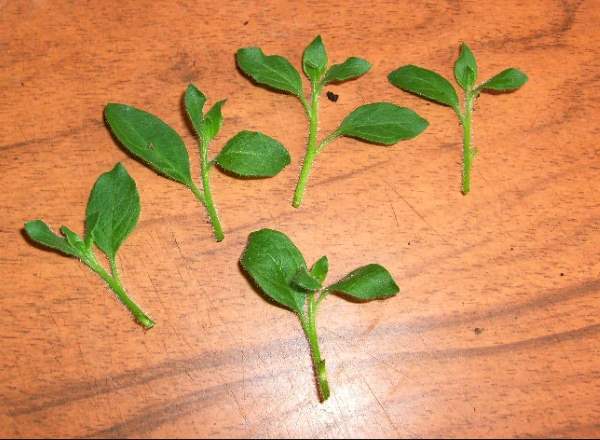

Cuttings
can be rooted in disposable, plastic, 100-gram cups. Use transparent cups so that you can see when the cuttings have roots.
You don't need a lot of soil for rooting; you can pour a little more than half into the cups. Priming
should be very loose and breathable. You can add coconut fiber, perlite, vermiculite to the soil composition - the soil will be loose and will be able to keep moisture.
Sprinkle the soil in the cups with plenty of water and prepare the cuttings for rooting.On the cuttings, remove all unblown buds, flowers, seed boxes, old, diseased, yellowed leaves.
Next, with a sharp knife, cut the petunia twigs into cuttings with 4-6 leaves
... Before planting, remember where the top is at the cutting, and where is the bottom, for proper planting in the ground.
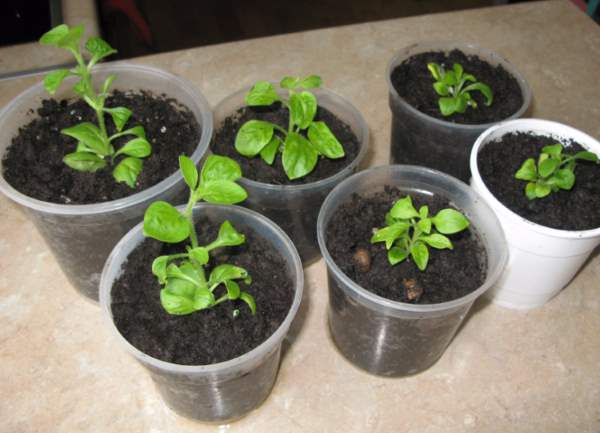

Next, we plant the cuttings in cups with soil, just stick the lower end into the soil. After planting, compact the soil around the cutting. To avoid overflows, do not forget to make drainage holes in the bottom of the cups.
Put the cups with cuttings in transparent plastic bags without holes and tie tightly. Thus, it will be supported desired humidity
so that plants without roots do not die.
Put the cuttings under the lamp
, they will take root for 1-2 weeks, it all depends on the variety.
What to do with cuttings?
If the size of the branches separated from the mother plant is large enough, they should be used to propagate the plant you like. To do this, the cuttings must have at least 5-6 leaves and a fairly strong stem. It is advisable to use planting material for propagation after repeated cuttings, when the bush becomes stronger and its stems are larger. They will quickly take root in a container of water, in which, for greater success, you need to dissolve a little root growth stimulant.
Remember to cut off the bottom leaves that are in contact with the water to keep the plant from rotting. Only a few upper leaves remain on the handle.
When young roots are formed, you can gently plant the petunia in a container with light fertile soil. If you grafted seedlings of a hybrid, a new specimen grown from a graft will completely retain the characteristics and appearance of the original, which is impossible when propagating from self-collected seeds.
To form a plant that is highly decorative, one pinching is not enough. If you do not care for an adult annual, then no matter what opportunities the breeders have laid in him, he will not show what he is capable of.
It is worth remembering the main points of skilled care.
- Regular root and foliar feeding with microelements and minerals to build up the vegetative mass.
- Careful selection of nutrient soil for pots and balcony boxes - it should be light and fertile.
- The introduction of iron into the fertilizer mixture for the prevention of chlorosis.
- Regular abundant watering (up to 6 liters of water per balcony box).
- Removing dead buds to stimulate lush flowering.
- Aphid treatment with a strong jet of water or pesticides, although pests do not settle on healthy, well-groomed plants.
- Treatment with sulfur preparations in rainy weather for the prevention of powdery mildew disease.
With proper pinching and following the rules of care, you will admire the long flowering of the amazingly beautiful plant for a long time.
So that your plant grows well, does not hurt and always pleases with flowering, you need to take care of it: remove dried shoots at the right time, fertilize and pinch.
Why do you need to do this? First of all, for the rejuvenation of the bush and reproduction, as well as for the formation of the desired shape.
Petunias are often planted in hanging pots and pots, in, grown. This plant is quite often found in.
Petunia lovers are constantly finding new ways to decorate using unusual varieties, and it looks just amazing.
When to cut petunias for storage
For the northern regions, grafting is best done from the end of August, the southern regions start grafting a month later - in September.
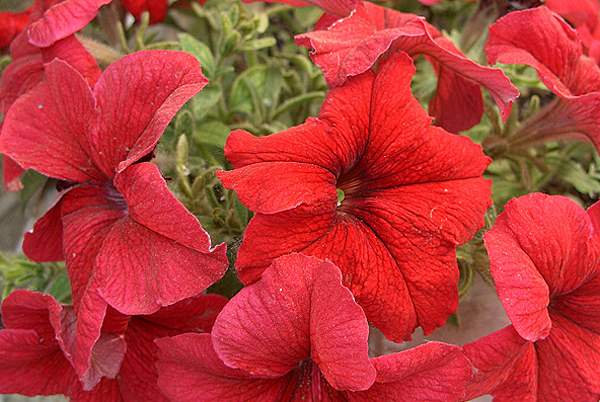

Rooting the cuttings on a light, sunny window will not work - this is not a seedling. Remember that cuttings have no root system - use shelving with lamps
(fluorescent or LED).
The optimum temperature for rooting petunia cuttings is + 15-20 degrees, not less
.
Approximately 1.5 weeks after you have put the cuttings for rooting, you can already look into the bags or look through the transparent walls to see if your plants have roots.
All cuttings with roots can be removed from the bags. We give 5 days to adapt to dry air and then the cuttings can be fed. In the soil without roots, they fed mainly on their leaves.
It makes sense to feed the cuttings only in the first month so that they build up a good root system.


All rooted cuttings are transplanted into 0.5 liter plastic cups
, in them they will grow until mid-January. Use a soil that is water and moisture permeable so that the root system does not rot in winter.
Petunia cuttings are best placed in a cooler place, especially if you cannot provide the plants with sufficient lighting.
Watering in winter is very moderate.
At the beginning of January transplant the cuttings into 2 liter pots
and petunias will grow the root system within a month, and then the leaf mass.
Already in mid February
you can start cutting your favorite plant for the new summer season.
Cuttings are cut in the spring in the same way as in the fall, although cuttings take root much better in spring.
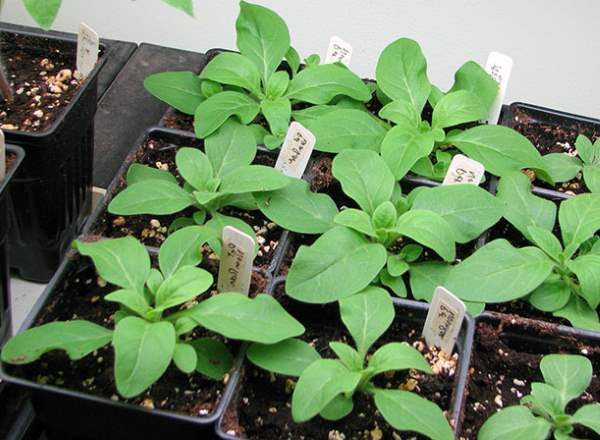

Thus, from one preserved and rooted plant, you can get a huge amount of seedlings, and not a re-grading, but precisely those varieties that you like.
There is no point in grafting bush petunias
- seeds are cheap, there are a lot of seeds in their bags, seedlings of bush petunias are very easy to buy in the spring.
Ampel petunias
sold in packs usually of 5 seeds, you need to choose carefully - the seeds quickly lose their germination.
If you decide to grow ampel petunia with seeds, then propagating them in the spring using cuttings will be very simple. Having sown early seeds for seedlings - at about the beginning of January, petunias will grow up in 1.5-2 months and you can cut off the tips of the branches and carry out cuttings from them.
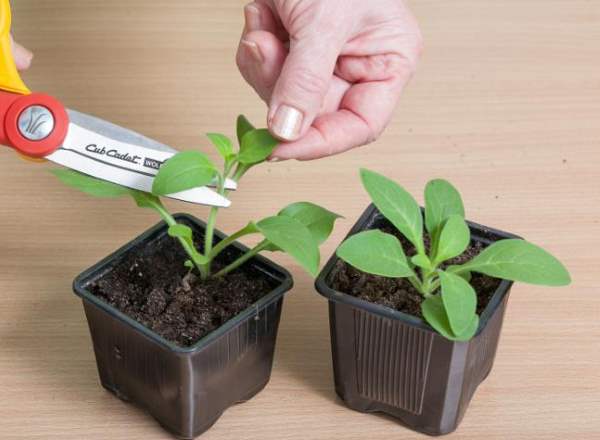

The cuttings will root quickly, and you will get the amount you need from 5 plants.
The main advantages of storing and propagating petunias for the winter is getting early flowering.
Video - Reproduction of petunia by cuttings. How to keep petunia in winter.
Petunias are truly gorgeous brightly colored flowers that look spectacular on the balcony, windowsill or in the front garden. The plant is perennial and loves warmth. If, with the onset of cold weather, you do not take care of comfortable conditions, it will turn into an annual plant. That is why many novice agronomists are wondering how to save petunia until next year or how to cut petunia for the winter.
How and when to pinch?
Pinching petunias should be done twice - at the seedling stage and after planting in open ground. If the second pinching with a lack of time can be neglected, then pinching at the seedling stage is mandatory. It is carried out when a young seedling has 5-6 leaves, a little less, but not more than this amount.
The algorithm is quite simple.
- With a miniature pruner, scissors or just your fingers, you need to pinch the stem of a young plant over the 5-6th leaf.
- To make the seedling recover faster after this procedure, you can water or sprinkle it with a growth stimulant such as "Epin" or "Zircon".
- A month later, when new lateral shoots begin to grow, pinching must be done again. Now it is carried out not only on the central stem, but also on the lateral shoots, which, after this procedure, will sprout of the third order.
- After repeated pinching, foliar and root feeding is carried out with full mineral fertilizer and a growth stimulator.
- It is advisable to pinch ampel varieties every 3-4 weeks.
All instruments for this operation must be, if not sterile, then at least sharp and clean.When growing an annual in greenhouses, the formation of a bush is carried out after the cut seedlings have taken root completely.
Rules for carrying out cuttings at home
Petunias are propagated in two main ways: cuttings and seeds. Sowing seeds is not always a rewarding affair as they often do not germinate. And some varieties cannot be propagated at all in this way, because the flowers do not give seeds. It is much easier to save and preserve plants by cuttings.
If necessary, cuttings can be carried out year-round. In this case, ampelous varieties and calibrachoa will be saved. But the most favorable time for cuttings is winter and spring (especially important for terry varieties).
Important: for grafting, it is recommended to use flowering mother plants, in this case, lush bushes will grow from their branches.
Cutting petunias for the winter
How to keep petunia until spring and how does petunia winters in general? Winter care for a potted plant in an apartment, cellar or basement consists in a moderate temperature regime, good lighting and reasonable watering. In the fall, the mother must first be transplanted in order to store it in favorable conditions.
Flower content
Petunia should be prepared for wintering. For this purpose, with the onset of autumn, it is necessary:
- Select the strongest and healthiest bushes.
- Carefully dig them out of the flower bed and place them in a pot filled with a mixture of soil and compost. This will give a good nourishment to the flower.
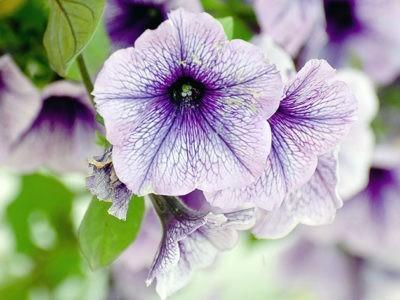

If frost is not expected, then the first couple of days after transplanting, let the flowers stand outside. This will reduce the stress of the plant. After that, they must be transferred to the house.
The air temperature should be +10 - +15. Flowers can be stored on the glazed balcony. Even if the temperature gets lower, it will not affect the plants in any way. Only the mark of the thermometer should not be lower than +2. Watering petunia in winter is necessary a couple of times a month.
All dry and spoiled leaves from the flower should be cut off. This is done with sharp scissors so as not to hurt healthy foliage and stems.
Important: If you take proper care of the plant, it will bloom at the end of winter.
Benefits of keeping petunias in winter
- Lush and early spring bloom. Adult crops or cuttings taken from them can begin to bloom as early as February or March. This can happen even in regions with unfavorable climatic conditions, for example, in Siberia, the Urals, etc .;
- Ease of obtaining adult seedlings. For this, there is no need to sow seeds, watch out for weak sprouts. Subject to all agrotechnical rules, the planted stalk begins to bloom after 2-2.5 weeks.
- Vegetatively propagating varieties of petunias will be stored until spring.
Prerequisites for pinching petunias
Proper cultivation and shaping is essential for a beautiful and healthy bush. In addition to timely sowing and diving, it is necessary to correctly pinch the petunia. This means that at a certain stage of growth, she needs to remove the upper shoots. This procedure will ensure the branching of the stems and the formation of many buds on the bushy crowns.
To carry out this manipulation, you will need the following:
- comfortable scissors or pruning shears;
- matured seedlings with 4 - 5 large leaves at the top;
- container for collecting removed cuttings.
Advantages and disadvantages of grafting
There are several ways to propagate a plant, but the cuttings method is the simplest. Even a novice agronomist is able to realize what he wants and extend the life of a plant. The benefits of propagation by cuttings:
- All the characteristics of the cultivated variety are preserved, including the color of the flowers.
- The root system forms and develops more actively, as a result the flowers bloom faster.
- You can use this method throughout the year.
- As practice shows, almost all planted cuttings take root.
- Using the seed method of reproduction will require much more effort.
- The most budgetary way to breed a culture. The use of seedlings or seeds is financially costly.
As for the disadvantages, they are absent. The only thing that needs to be adopted by the agronomist is that uterine samples, whose shoots will be used for reproduction, should not have mechanical damage, should be healthy and without obvious signs of pest damage. Otherwise, it will not be possible to propagate petunias, young shoots, most likely, will not take root and die.
Petunias, despite their attractiveness, are rather wayward and capricious flowers. But if you follow agricultural techniques and study all the rules of cuttings, it will delight the eye with lush flowering.
Description and characteristics of the petunia plant
Let's start the description of the petunia plant with the fact that it comes from Argentina and Brazil. In their homeland, the plants are perennial, but we do not hibernate and are used as annuals. Of course, modern garden hybrids are very different from their wild ancestors. The main breeding work on their creation began in the middle of the 19th century in America and continues throughout the world to this day. There are more than 25 species, among which there are small-flowered forms with a plant height of 20 to 40 cm, blooming 70-75 days after germination, and large-flowered, the height of which can reach 60 cm. These petunias bloom two weeks later than small-flowered ones. There are terry ampelous forms, the shoots of which can reach more than 1 m in length.
Petunia leaves can acquire light or dark shades of green, their shape is oval, length from 6 to 12 cm. Petunia stems are straight, with densely spaced branches.
In the process of development, a bush of the correct silhouette is formed, which eliminates the need for decorative pruning. The only thing that is required is pinching the top for a more intensive growth in width.
In its natural habitat, petunia reproduces by the seed method. Its seeds ripen in a bivalve capsule and are very small (0.8 mm). In one box, it can easily ripen, and then sow about 100 seeds.
To obtain planting material, the most decorative bushes are transplanted into pots in autumn, and used for grafting in spring. Large-flowered petunia is more thermophilic than small-flowered petunia. In rainy weather, it loses its decorative effect, and the agricultural technology of its cultivation is more complicated. Therefore, it is more often used as a pot culture.
Cuttings in summer
At home, petunia is a perennial plant. With our climate, the plant cannot grow year-round. But if you create the right climate in summer and protect you from the winter wind and temperature, you can enjoy it all year round. To do this, in the fall, you just need to transplant the plant from the flower bed into the pot. In the summer, reproduction by cuttings will allow the petunias to be planted again in the flower bed.
When the seedlings begin to touch, transplant them into separate pots or six packs. Fertilize them every two weeks with an all-purpose fertilizer and water them when the soil is dry to the touch. And we can, of course, plant them in vats or boxes. For good flowering, they need full sun, relatively rich soil, and watering when the soil begins to dry out, and weekly watering or rain is usually sufficient for petunias grown outdoors, but it's not uncommon to water a petunia grown in a pot or basket every day. if it's hot.
The very reproduction of a flower by cuttings can be done in one of the following ways:
- With the help of seedlings.
- With the help of last year's plant.
- Using cuttings in water.
The first way is pretty simple. To do this, you need to tear off 1 favorite stalk, the length of which should be 8-10 cm and have two internodes.You should plant these seedlings in a flower pot, after moistening the soil in it. The soil must be moistened every day. As soon as the young shoot gets stronger, it can be left in a pot or planted in a flower bed.
Nurseries produce them by cuttings, a more expensive method, which is why the spring of these varieties is so expensive. Petunias are usually allowed to freeze at the end of the summer season, but during the winter, cuttings can be taken and grown indoors. Ideally, you will take your cuttings at the end of August, because late cuttings are difficult to root. Clip your "window petunias" from time to time and they will have many branches in March that you can cut off to produce all the plants you need to fill your pots and summer beds.
Celebrate the year of petunia by growing this lovely light crop factory! From the shrub to develop many large size flowers, elegant shape and vibrant colors, which are a strong point for every garden or green space. Rain and weather are unlikely to spoil the flowers of Surfinia, which fears excessive wind and an overwhelming winter. Therefore, in winter, it is recommended to protect the plant with a material that in any case ensures adequate ventilation and the passage of light or its transfer in closed and protected areas.
The second method is similar to the first. But in this case, last year's plant is used.
The third method involves using water instead of soil. This method has a number of features:
- the future seedling should be placed in an opaque dish;
- if a certain amount of water evaporates, it is not worth changing it completely. Just add the required amount;
- You can create a greenhouse effect by covering the plant with a plastic bottle or transparent plastic bag. If this is the case, remember to ventilate the plant every day to avoid mold growth.
For reproduction in water, a stalk up to 10 cm long prepared in advance must be removed from the lower leaves and the base must be puffed. Although some growers do not do this, claiming that without this the cutting will take root.
Watering should be abundant and frequent, even several times a day during warmer months, trying to avoid excessive water stagnation by damaging the plant. Appropriate and careful maintenance will be rewarded with abundant flowering from June to the end of October. In the first case, the branch will be cut into the ground, and it will be introduced in a short time, and in the second case, it will be enough to digest the seeds in fertile soil suitable for plant growth and fertile enough. The best time for pruning is summer, roughly July, in favor of a second bloom.
The prepared stalk is dipped in a bottle or a special container with water. The water level should be up to the middle of the cutting, otherwise the plant will have an excess of moisture. The container with water and the shank must be placed in a place well-lit by the sun and wait for the shank to take root. It will take about a week. After that, you need to plant the plant in a pot; in the summer you can go directly to the flower bed. Remember to moisturize the plant every day.
You can cut the branches about half their length to encourage new shoots to emerge; during the regeneration period, it is advisable to reduce the frequency of watering, and then resume with the usual regularity, as soon as the sprouts are germinating. Pruning is also important to ensure proper lighting and adequate ventilation for indoor branches, promoting the development of all flowers and ensuring adequate nutrition. The main external agents that can seriously damage the plant are aphids, small parasites that appear with white spots on the leaves and flowers.
General information
Petunia is an amazingly delicate and cozy flower, a characteristic feature of which are flowers similar in shape to small gramophone, as well as curly stems, in connection with which petunias are often used by gardeners for interior and exterior decoration. The popularity of the plant is also explained by its rich color: from white and pale pink to dark purple. Sometimes there are bicolor and multi-colored species.
The homeland of petunias is the tropical regions of South America, where more than thirty species of this amazing plant have already been described. The bloom of petunias begins in late June and can last until the end of autumn. Many species, both original and hybrid, belong to perennials, but, as a rule, gardeners prefer to grow them as annuals, since they do not tolerate frost well.
Cascading petunias
A significant difference between this type of flowers is the peculiar arrangement of the stems: they reach 1 meter in length and spread along the ground or go down in vines. With the help of such petunias, you can decorate rock gardens, special designs in the form of nets and frames, hanging pots.
Today, the falling type of petunias has been supplemented by flowers from the category of semi-ample flowers, which do not have such long stems. They can grow a little up, and from there go down. Thus, a real waterfall of wattle fences is formed. Decorating alpine slides with such plants, you can create a semblance of a river of flowers, which descends and winds between the stones.
They can be used to decorate trees, benches and other structures on the site. They should be planted with seedlings, since small shoots are fragile enough and need maintenance.
Reproduction
You can propagate petunia by cuttings in the summer.
- From a healthy plant, lateral cuttings (7 - 10 cm) with 3 - 4 true leaves are cut.
- Cuttings are planted in separate pots, watered and covered with jars. It is necessary to maintain optimal soil moisture and regular ventilation. The favorable temperature for rooting is 22 - 23 degrees Celsius.
- After the formation of leaves, pinching is done, and then planted in open ground.
The process of growing petunias cannot be called quite easy, since there are many nuances and difficulties in this matter. However, with the right approach and following the recommendations, this is quite possible. And then all the work and efforts will pay off with the wonderful flowering of the petunia.
I really like petunias grown in flower beds, but I saw them in pots. And recently I was presented with a beautiful petunia in a hanging planter. Please tell me how to care for a petunia in pots so that it blooms all season?
The varied flowering of petunias attracts attention and arouses the desire to decorate with amazing plants and your yard. Caring for petunia in pots is to follow a few simple tips.
Transfer
After wintering, you need to take care of transplanting petunias from pots, or rather, about its reproduction. This requires:
- Cut off cuttings (10 cm each) from the mother plant, while cutting the upper leaves in half, and remove the lower ones.
- Place the cuttings in a phytohormone solution.
- In boxes with loose soil or wet sand, plant the cuttings to a depth of 3-4 cm and water.
- Cover the containers with foil (glass) and place them on the windowsill.
- After the first leaves appear, the cuttings should be transplanted into small pots, and after the formation of 4-6 leaves, pinching is done.
- After about a month, petunias are planted in larger pots, and in mid-May, in a permanent place, in open ground.
Cuttings in winter
In order for the reproduction of petunias by cuttings to be done in winter, it is necessary to provide it with warmth and optimal temperature.
The ideal place would be a room with a temperature of about 16 °, light and cool enough. This propagation by cuttings is similar to what is done in the summer. But there is one important detail. Indoors in winter, the plant needs to be periodically illuminated with a lamp.
Aphids cause growth retardation and destroy flowers, and then plant death if completely colonized. Therefore, it is important to locate the colony at the start of an attack in order to effectively eliminate the presence of parasites. If the colony is only at the beginning and in a localized area, it will be sufficient to eliminate a small affected part; Otherwise, it will be important to resort to chemical control of specific products to ensure that the aphids are completely eradicated. The most likely time for aphids or other parasites to attack is spring, when plants resume their growing cycle.
In severe frosts and when applying fertilizers, it is necessary to highlight the petunia 10-16 hours a day. When the plant has a sufficient amount of greenery, you can start breeding petunias. As noted above, the breeding method is the same as in the summer.
A third of the length of the cutting must be placed in the soil. For two weeks, it is important to provide young seedlings with a greenhouse. To do this, you can cover the plant with a plastic bottle or glass jar.
Features of propagation by cuttings
Withered flowers or slow growth can also be signs of poor growing conditions, while stagnant water can cause root rot or excessively dry soil can dry out the plant. Solving optimal growth conditions will be the solution, while plant monitoring will be a major wake-up call for any problems that may arise. Vintage is a relatively small variety known in Bulgaria. In its homeland, Madagascar, the plant is considered a weed.
Remember to ventilate this greenhouse to prevent mold from growing on the plant. Also, keep an eye on soil moisture and water the plant daily.
Reproduction of petunias produced by cuttings contains the properties of the mother plant. The planted cuttings strengthen and develop much faster than when planting seeds. Thus, we can say that this method of reproduction is simple, and the flowering of petunias occurs 2-3 weeks earlier than the flowering of those that were grown from seeds.
In other warm countries, it is considered an invasive species - even ants carry their seeds. And here is its decorative value. The winery successfully replaces petunias in summer. Another type of winch is grown on our territory as a perennial plant - a winter garden. The similarities and differences between them are many and few.
In the Philippines, soldiers during World War II used Madagascar instead of winter potion instead of insulin. As a result of this discovery, research began on its chemical composition. There are a number of laboratory experiments with mice that show that the worm contains over 30 alkaloids, along with other chemicals that affect various forms of cancer, including childhood leukemia.
Bright petunia is a fragrant plant, a colorful symbol of a carefree summer, which you involuntarily admire, every time you pass by a blooming flower bed. Such a variety and splendor of color, like that of a petunia, can be the envy of any garden annual flower. If you decide to add bright colors to your flower bed, pay attention to petunia, because it will not be difficult to grow and propagate it by seeds or cuttings.
We offer curb and cascade
The plant has thin, light green to almost white stems with successive oval leaves. They are smooth and shiny, they have no shelter, and when they are injured they run out of milk juice. Flowers with 5 petals that form at the base and form a thin tube.
It is for this reason that only butterflies can pollinate them. However, the screw can be self-polishing. Crops are in the form of a pod, in which small seeds are located.They have the ability to germinate in the same year under appropriate conditions and maintain inheritance for at least 2-3 generations.
Did you know?
The first petunia flower described in history was white and was found in Uruguay in 1973. Petunia was originally called "nicotinia" in Latin, but later it was renamed "petun", which means "tobacco" in Portuguese, since petunia and tobacco are related plants.
Cellar preparation
The beautiful, bright, lush flowers that often adorn gardens and balconies are petunias. Many housewives strive to preserve the plant for the next year. Therefore, you need to know what conditions in the room are necessary for the flower so that it painlessly endures the cold. The room in which the pots will be located must meet the standard criteria:
- The room should be light. It is undesirable to keep the plant in the cellar all winter; it can be moved to a lighter and warmer place closer to spring so that the cuttings can be prepared in time.
- Indoors, it is necessary to maintain a temperature regime that is comfortable for the plant. The temperature for petunias should not be very low or high. The optimal value is + 10 ... + 15 ° C. It's okay if the temperature drops a little. The main thing is to keep it at + 5 ... + 6 ° C.
- The humidity level should be medium. With an excess or lack of moisture, the flower may die.
If there is no cellar in the house, you can adapt another room for storing petunias that will meet the specified requirements. Such rooms can be glazed verandas, insulated loggias, balconies, etc.
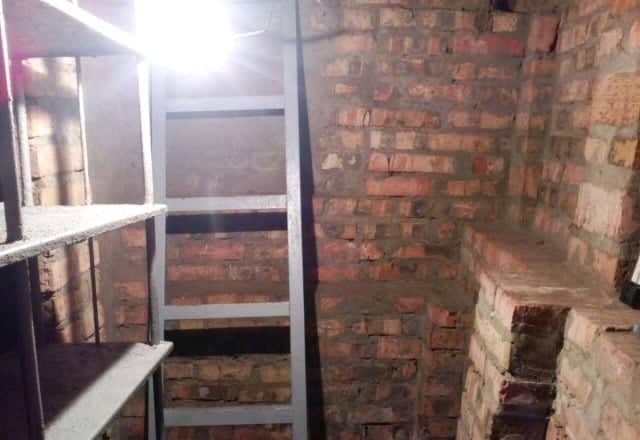

Cascading Pitunias
Petunias are becoming more and more popular every year. Previously, bushes with pretty bright phonographs were grown mainly in parks and near public institutions. Recently, more and more flowering plant adorns the facades of houses and cafe verandas, growing in hanging containers and multi-tiered flower beds. The thing is that the choice of varieties of flowers that can be purchased has significantly expanded: along with bush forms, cascading and ampelous petunias have appeared on sale.
A lot of discussion raises the question, what is the difference between ampelous and cascading petunias? Cascading petunia is an average between bush flowers and ampels. In fact, cascading varieties are a group of ampelous ones. They have flexible stems, but thicker and not as long as in purely ampelous forms, and cascading petunias grow at first, stretching upward, and then begin to hang under their own weight. Usually, varieties of cascading petunias have larger flowers than ampelny ones.
These include such varieties as Silver, Typhoon, Tornado, Cherry, Ramblin, Fortunia, Easy Wave and Rose.
When to cut petunia
I transplant terry petunias in early August, so that the plant still has time to root well, they tolerate transplanting quite simply, it is advisable to dig it out with a large clod of earth.
And the varieties of ampelous petunias, I plant them in separate pots in the spring and bring them into the house with the onset of cold weather. You can transplant them in the middle of summer, but I noticed that not transplanted ampelous varieties are preserved better.
If you do not want to touch the plant in the flowerbed in the summer, you can cut cuttings from it in late June - early August, root them and, already rooted petunia, save for the winter. According to my observations, such plants tolerate winter more easily in an apartment.
Petunias take root easily. From a flowering plant I cut cuttings with two internodes, cut the leaves. It is better to use not the apical parts of the shoots, but the lateral basal offshoots 7-9 cm long. The main thing is to carefully monitor so that the soil does not dry out. After 7-10 days, roots appear.I transplant the rooted cuttings into pots with a diameter of 12-15 cm, in which they will winter. I always feed the plants with complex fertilizer.
Possible problems and diseases
The most common pests and diseases for petunias are:
- Aphid. The main symptoms of the appearance of aphids are leaf deformation, wilting. It can be diagnosed by the appearance of shiny dew. In such cases, it is necessary to treat the plant with special agents (for example, Aktara, Taran, Kemifos).
- Whitefly. It appears on the lower parts of the leaves and resembles a moth. It leads to wilting and yellowing of the leaves. They treat whitefly with Taran or Aktara.
- Spider mite. The leaves of the affected plants brighten and subsequently become covered with dark spots. To combat the tick, they are treated with Demitan or Apollo.
- Powdery mildew. Plants affected by this disease are covered with a white bloom. New leaves grow twisted, and old ones fall off. The main reason for the appearance of the fungus is improper watering. Plants are treated with fungicides (Forecast, Vitaros, Previkur).
Optimum temperature for petunias
The temperature regime required for a plant to grow rapidly depends largely on the variety chosen. As a rule, to obtain friendly shoots, the container with seedlings must be stored at a temperature of 20-25 ° C. Some hybrids are able to germinate at lower temperatures, which must be indicated on the seed package. In general, petunia is a thermophilic plant. In winter (during the dormant period), the optimal temperature can be called 10-18 ° С, and in summer - 25-30 ° С. Note that flowering will not begin until the average daily air temperature rises above 19 ° C.
What is this plant?
Petunia is a perennial plant in the nightshade family. Often grown as an annual. There are many varieties of petunias, which differ from each other in color and shape of flowers. It can be in the following colors: red, yellow, white, cream, blue, light blue, purple and many other shades.
The shape of petunia is:
- ampelous;
- bush;
- cascading.
Bushes can be miniature (up to 30 cm), and can reach 70 cm.
REFERENCE! Petunia is a relative of tobacco. Her homeland is South America. It was introduced to Europe in the 18th century.
How to save petunias until next year?
To preserve the beautiful begonia until the next season, it is necessary to properly organize her rest period. In most cases, with the arrival of summer and the onset of warm fine days, flower growers try to take their plants out into the open air. Even indoor begonias feel much better outdoors. They gain green mass more actively, form new shoots and buds. In anticipation of the cold weather, the pot with the plant from the street must be transferred to the room. Now it's time to prepare him for rest, which means that watering needs to be reduced. In principle, they start to water the bush less often while they are in the fresh air, and when the flower “moves” into the house, the soil does not need to be moistened at all. After all, the tubers must be able to dry out before being stored. If possible, the plant can be left in the pot for the winter. All shoots will need to be cut off beforehand. Place the pot in a dry room with a stable positive air temperature, for example, in a basement. If there is no basement, the tubers should be stored in the refrigerator on the lower shelf. Before storing, begonia should be removed from the flowerpot and freed from the substrate. Then carry out such events:
- cut off the shoot from the tuber;
- cut the roots with scissors;
- leave the tubers so that the cut dries well.
Put peat in a bag and place begonia tubers there. Instead of peat, it is good to use moss - sphagnum.
Varietal variety of petunias
Among the hybrid varieties of petunias, there are multi-flowered, large-flowered, floribunda, garden.
In multi-flowered petunias, the flowering period begins earlier. It blooms profusely and for a long time, the diameter of the flowers reaches 6-9 cm. Such varieties are extremely unpretentious and are ideal for our climatic conditions. Among the most popular are Mirage, Plumkrystals, Fantasy.
There are more than a hundred varieties of large-flowered petunias. Such plants bloom worse than multi-flowered plants, but the flowers are larger and more beautiful. They come in different heights, have double fringed flowers. However, they are more vulnerable - wind or rain can easily damage them. Such petunias are often grown on balconies. Among the most popular are Pikoti, Hit Parade.
Floribunda combines the beauty of large-flowered varieties with the unpretentiousness of multi-flowered petunias. The disadvantage is that these petunias look spectacular only when grown on a large scale, so they are used to decorate large flower beds. Sonia and Celebrity varieties are in demand.
Garden petunia is also called ampelous or balcony. The plant has creeping stems hanging down. This type is used to decorate balconies and loggias - garden petunias are resistant to weather conditions, grow quickly. You can often find varieties of Tumbelina, Surfinia.


Fertilizers for petunias
Petunia, like many other plants, responds well to additional nutrition, which is reflected in a lush bloom.
Top dressing in June
Consider some of the fertilizer recipes:
- Two weeks after planting the plants in the ground, potassium monophosphate is added to the soil. To prepare a solution, 5 g of the substance is diluted in 10 liters of water.
- Once a week, petunias can be fed with Zircon by diluting 1 ampoule in a bucket of water.
- Florists often use the drug Kemira "Lux". It contains macro- and microelements necessary for lush flowering. In addition, after fertilization with Kemira, the resistance of plants to diseases increases, and the flowers become brighter.
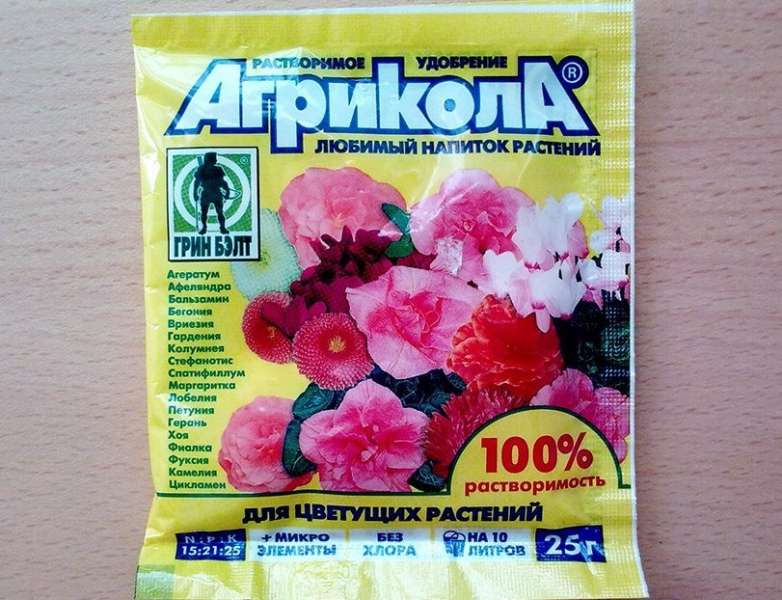

Top dressing in July and August
With the rapid flowering of petunias in mid-July, they are fertilized with mineral elements every five days.
In case of poor flowering, once every two weeks, petunia is fed with urea at the rate of 10 g per 10 liters of water. Nitrogen will improve plant growth and ensure lush flowering. As soon as improvements are noticeable, the application of this fertilizer is stopped. In addition, in July, the introduction of organic matter should be stopped, since the plants will be inhibited, as a result of which the flowering will only worsen. From the onset of August, plant feeding is carried out with Fertika and potassium monophosphate once a week. Less frequent use of fertilizers by the end of summer is due to the fact that the bushes will already be quite developed and blooming profusely.
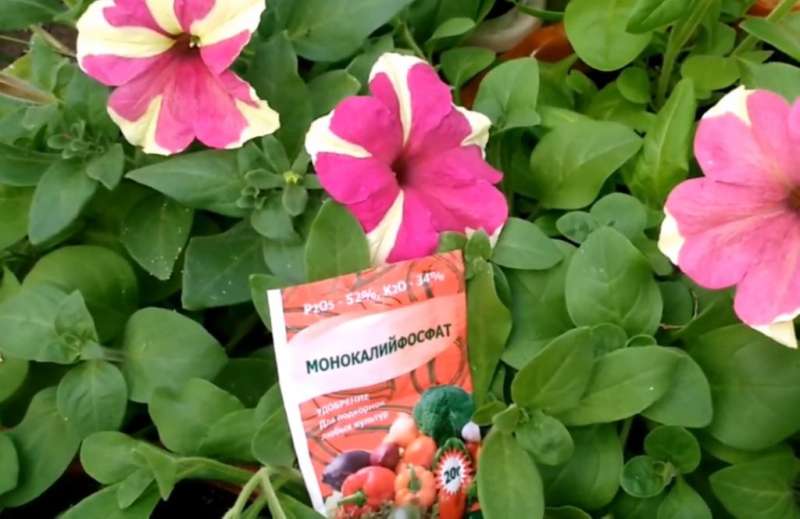

Pruning petunias
The key to a lush and bright flowering is the regular removal of fading inflorescences. If you neglect this rule, then the plant will direct all its forces to the ripening of the seeds, and the subsequent flowers will be small and, possibly, not so bright.
Sometimes the gardener may notice that in the middle of summer the petunia bushes began to lose their decorative effect, the flowers became smaller and sparse, and the stems were too long. In this case, it is recommended to carry out a rejuvenating pruning, leaving stems no more than 15 cm long in bush forms, and cutting off exactly half in ampelous ones. Young shoots will grow very quickly and the petunia will bloom again, delighting with its beauty until the first days of November.
In the fall, you can dig out bushes and organize the planting of petunias and caring for it in an apartment. In this case, the plant is planted in a pot, and the stems are cut off. Throughout the winter, the substrate is slightly moistened and new shoots may appear in February. Some growers cut them off and plant them in nutritious soil, caring them like a cuttings of a houseplant. This method is suitable for those who find it too troublesome to grow seedlings from seeds.
Fresh articles about garden and vegetable garden
How to water petunia
Water the petunia liberally so that water starts to come out of the drainage holes.In this case, there will be confidence that the clod of earth is completely wetted. Usually in summer, petunia is watered 2 times a day - in the morning and in the evening. An important rule of thumb: never start watering if the hot sun is shining on the flowers. You will ensure that the roots in wet soil begin to "boil", and this can lead to the death of the plant. According to the focus of your balcony, create your own watering schedule. For example, if the direct rays of the sun fall on it from 8:00 to 14:00, then water the plantings at 7:00. And at 15 o'clock (or a little later, for example, immediately, as soon as you come home from work in the evening).
Please note that in May - early June, when petunias are already sleeping on the balcony (street), it is still quite cool at night. Therefore, try not to water the plants late in the evening to avoid hypothermia of the roots. The same can be said about autumn - September and October. In the summer, such precautions are irrelevant.
Common mistakes of florists
Novice growers can make a lot of mistakes. Let's take a look at some of them:
- Fledgling seedlings. If you pinch weak, fragile seedlings, which are still poorly rooted, and look sluggish. In this case, you need to wait a little, creating favorable conditions for the plant: add artificial lighting or add the missing fertilizer. It is possible that the soil does not meet the needs of this plant. It is necessary to find out the cause and eliminate it.
- Processing with one instrument without subsequent sterilization. You can easily bring in the spores of pathogenic fungi or other diseases.
- It happens that they overlooked and one shoot quickly stretched out and even the bud released nothing terrible, just pinch the shoot over the third pair of leaves. The flower must be removed without pity, more flowers and even larger ones will appear in its place.
- Early pinching. If the plant has not yet formed 5-6 leaves, pinching will not affect the best way. Since after pinching the remaining stem will become woody and many dormant buds will wake up. A young plant may not cope with such a load and will simply die.
- There is an opinion that it is not necessary to pinch the hybrids. But if they grew in unfavorable conditions for them, then to form a beautiful bush they still need to be pinched.
Why isn't this happening?
If the petunia does not bloom by the expected date, then it is recommended to pay attention to the following conditions:
- Pot volume and distance between plants. Remember that petunia is a plant with a strong root system, so you need at least two liters under each plant. Tip: it is recommended to thin out or transplant petunias.
- Insufficient soil moisture. Petunias love abundant watering, but they often do not need to be watered, otherwise the root system may rot. Commensurate watering with the age of the plant. Young petunias should not be watered abundantly, since their root system has developed incompletely.
- Insufficient light level. Petunias are light-loving plants, which means that it is recommended to choose the lightest and sunniest areas for them. Exposed sunlight can damage the leaves of the plant, so make sure that the plants are sufficiently hydrated.
- Lack of feeding or incorrect feeding scheme. How to feed a flower for abundant blooming? Plants require nitrogen fertilizers to thrive, and phosphorus and potassium fertilizers to bloom. Therefore, the following scheme is optimal: first you need to water the plants, then add a sufficient amount of organic or mineral fertilizers, then water again and add mineral fertilizing for the leaves. Remember the frequency of actions. It is not recommended to exceed the required amount of watering or feeding.
- The appearance of the plant. In order for the plant to bloom profusely, it is recommended to pinch the top, leaving five leaves. This method will stimulate the development of additional shoots.In addition, it is necessary to regularly remove wilted flowers, as this will become a stimulating factor for a new round of flowering.
Knowing and applying tips for growing petunias, you can achieve long and abundant flowering, and this will undoubtedly cheer you up and your loved ones.
When is the best time to propagate petunia
Petunia cuttings are stored for a very long time. Therefore, this plant can be propagated all year round. It should be noted that the larger the container in which the stalk is located, the stronger it will grow and the more magnificent it will be when planting in a flower bed or in a pot. The only thing to consider is the region in which you live and its climatic conditions.
In addition, there are colorful petunias, marbled, double and semi-double, with a fringed or wavy edge and more. Several forms of petunia have been created on hand by the hybridizers. Grandifloras, which produce large flowers with a diameter of 10 cm, are the most popular. It is in this category that we find the widest variety of varieties. On the other hand, their flowers are damaged by rain.
Wave Violet was the first petunia fall offered by seeds. The Wave Violet creeping petunia was the first falling petunia offered by seed. In Quebec, petunia is still often referred to as "Saint Joseph" because of the tradition that it should be sown on the Feast of St. Joseph, March 19. And it is true: the seed is early enough, in the middle of March, it is necessary to receive flowers from the beginning of June.
Vegetatively propagated petunia grows and blooms faster than when planting the seeds of this plant. Approximately two months pass from the moment the cutting was cut, after which active growth and flowering begins.
10-15 days for petunias to take root and take root in the new soil. After that, it begins to bloom actively. So, for example, when cuttings in March, petunia can bloom in May.
How to form an ampelous petunia
Petunias are not difficult to sow, but the seeds are very small, like dust. Fill a pot or tray with moist artificial soil and plant seeds on the surface without covering them. Instead, squeeze them with a small piece of wood to adhere to the jellied soil, then spray lightly with warm water.
The seeds should grow in 7-10 days. Then remove the dome or film and expose the plants to more light: full sun or place them 10-15 cm away from a fluorescent lamp, illuminated 14-16 hours a day, and, if possible, lower the temperature.
How to plant correctly?
Petunia can be planted in the ground with seeds and seedlings. The second option is most often used. It is easier for a novice florist to purchase ready-made seedlings at the initial stages.
For planting petunias, you must choose a light, windless area. She also tolerates partial shade well. A few days before planting the seedlings, you need to fertilize the soil with humus, and 3-4 days it is recommended to take it outside. Landing is carried out in the evening or on a warm cloudy day.
The distance between the holes depends on the plant variety. The optimal distance between them:
- 18 - 20 cm - small varieties;
- 20 - 25 cm - large varieties;
- 25 - 35 cm - bush varieties.
Before removing the seedlings from the container, you must first water it well. They are planted in the hole together with an earthen lump. The soil around the seedling is tamped and watered abundantly with warm water, and sprinkled with peat or humus on top. The first couple of days after planting the petunia should be protected from direct sunlight.
ATTENTION! You can not fertilize the beds before planting petunias with fresh manure, as it can provoke fungal diseases.
Planting petunias after winter storage in open ground
In the fall, you should not strive to stimulate the further growth of petunias, because the plant needs to prepare for wintering. By February, you will notice new buds on the plant.At first, the shoots are fragile, pale and weak, so our task is to "wake up" them later. In March, petunia comes to life and very soon will start to delight you with its first buds.
In mid-March, we transfer the container with petunia to a warm and bright place. The most important thing during this period is lighting! We begin to resume watering with warm water and systematic feeding. At the end of March, we select young shoots of petunias 5-7 cm long. Cut off with a "heel" and plant in a container with fertile soil or in a peat tablet. We water, build a "mini-greenhouse" in a pot and shade. We try to ventilate the cuttings regularly, water them very carefully, spray them until rooting (about 3 weeks). Watering petunia is necessary as the soil dries up. Abundant watering, as well as overdrying an earthen coma, is unacceptable. Novice gardeners will find it easier to root the cuttings in cups of water. Very soon, the rooted petunia begins to bush and bloom profusely.
Petunias are planted in open ground in the second half of May, when the frost is already over. To do this, choose a cloudy day or evening time, so that the adaptation is more successful. The plant is suitable for loamy or sandy loam fertile soil. It can be fertilized with humus or compost.
Seedlings in pots are watered, after which they are carefully removed along with a lump of earth and planted in prepared holes at a distance of 30-40 cm from each other. If the soil is acidic (pH less than 5.5), then lime is first added to it.


Articles for gardeners
Pruning apricots in spring diagram
Pruning grapes in spring: video for beginners
Pruning shrubs in spring
Pruning trees in spring video for beginners
Watering rules for petunias
Petunia is a light-loving plant, therefore, so that the whips do not stretch out in search of the sun, the pot is placed in a sunny place.
It is not necessary to water the plant at the root often, but abundantly. And if the summer is very dry, watering is necessary every day. And vice versa - when the rains are frequent, the pots of flowers are hidden so that they do not rot from an excess of moisture.
To form a beautiful lush bush, pinch petunia after 4 leaves. If the flowerpot is in a well-lit area, pinching once will be sufficient. But when the plant is in a darkened place, you need to do it regularly. A feature of caring for a potted petunia is the flower's need for rest, therefore, at the end of autumn, the pot is transferred for 2-3 months to a dry room. At the same time, watering is reduced and long branches are cut off. With the onset of spring, the flower is again taken out into a warm and bright room, watering is restored and the soil is renewed in an old pot, or the petunia is completely transplanted into a new soil.
Shower for petunia
On dry summer days, petunias should be sprayed with warm water from a spray bottle. This will be a good prevention against spider mites and will saturate the plant with moisture from the outside. Abundant evening spraying has a great effect on the condition of petunias, making them healthier and stronger. Spraying should be done when the sun is leaving your balcony. Otherwise, sunburns will necessarily remain on the plants - the rays will pass through the water droplets, as through lenses and burn through a leaf plate.


